“See, I asked you, and you would not listen to me. So I asked my Lord, and He has listened to me.”
– Saint Scholastica
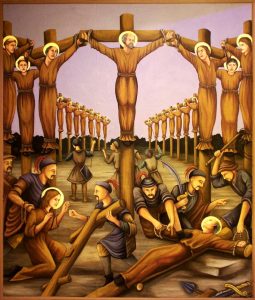 The Martyrs of Nagasaki, St. Paul Miki (1562–1597) and his twenty-five companions are liturgically honored today. As you note from the image he was crucified for the faith in Nagasaki, Japan, in 1597.
The Martyrs of Nagasaki, St. Paul Miki (1562–1597) and his twenty-five companions are liturgically honored today. As you note from the image he was crucified for the faith in Nagasaki, Japan, in 1597.
Historians tell us that Miki was Japanese layman of great nobility and wealth, who converted to Christ by the great missionary, St. Francis Xavier. The Church, initially, was not in opposition to the Emperor and his princes but as time went on Christians were felt to be a threat to Japanese culture. Paul Miki and his companions were tortured and made to walk 600 miles to Nagasaki before they died. Given the option for personal freedom if they denied Christ and the Church, Paul remained steadfast to the Faith. I wonder how many of us would do the same today?
For the month of February, the prayer intention of Pope Francis is:
That those who have material, political or spiritual power may resist any lure of corruption.
Let’s ask for the grace to be steadfast to the Gospel and teaching of the Church.
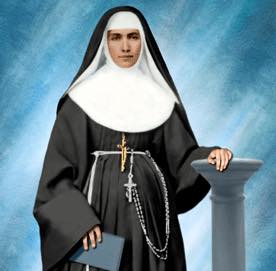 The Church in America liturgically remembers St. Marianne Cope (1838–1918), also known as St. Marianne of Molokai, today.
The Church in America liturgically remembers St. Marianne Cope (1838–1918), also known as St. Marianne of Molokai, today.
A German immigrant to the USA, Marianne worked in a New York factory before entering the Sisters of the Third Order of Saint Francis in Syracuse. Her superiors missioned Sister Marianne to a ministry in health care and education where she excelled. Called to serve the poor, and by Divine Providence, Hawaii opened the door for Mother Marianne and six sisters to go on mission in 1883. There she gave 35 years to caring for those afflicted with Hansen’s disease (leprosy) in Molokai, Hawaii, establishing a hospital and a school for girls on the island of Maui. She is remembered for introducing cleanliness, dignity, and fun into the colony. Despite her direct contact with leprosy patients over many years, she was not afflicted by the disease, which some consider miraculous. A gift for Sister Marianne was collaborating with St. Damien of Molokai. Benedict XVI canonized Marianne Cope in 2012.
Are we open to the promptings of Divine Providence?
Indeed, working in the soil is a good you on many levels, not least on the spiritual and affective levels. We know getting out in the fresh air and working is good exercise. Experience tells me that our whole disposition changes for the better. There is a story that when a certain Dominican nun who was having a difficult day with the novices, she would go to the garden in her monastery. Sr. Columba also encouraged the novices to do the same.
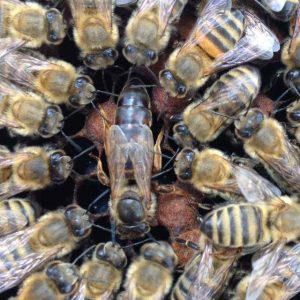 This past week I’ve been settling my commitment to my small agriculture for 2018 with the ordering of some new bee hives, placing an order for new honey bee colonies. This year, I am getting a new species of honey bee from Canada called Saskatraz. This past year I year I had some sort of Russian-mix bee. But I had some issues with the colonies and it’s very possible that only one of three colonies survived.
This past week I’ve been settling my commitment to my small agriculture for 2018 with the ordering of some new bee hives, placing an order for new honey bee colonies. This year, I am getting a new species of honey bee from Canada called Saskatraz. This past year I year I had some sort of Russian-mix bee. But I had some issues with the colonies and it’s very possible that only one of three colonies survived.
I have adopted the motto: save the honey, save the church. You could also replace “church” with “culture” or “the family.”
Committing oneself to the honey bee is a commitment to a 100 million year history of life. The honey bee is one of the most amazing insects God has given us! You can’t underestimate the importance of the honey bee in human and animal life. And yet, we humans are not too aware of our actions that obstruct or even kill the bee due to shallow desires like the eradication of dandelions and white clover. Nevertheless, I am doing my part. I daily pray for my honey bees and I have developed an affection for them.
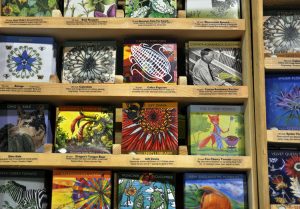 Likewise, I am beginning to organize my mind on what may be planted. With all the seed catalogs I’ve received there is no shortage of ideas; there is a shortage in space and energy to do the work.
Likewise, I am beginning to organize my mind on what may be planted. With all the seed catalogs I’ve received there is no shortage of ideas; there is a shortage in space and energy to do the work.
Back in November 2017 I planted approximately 15 pounds of garlic in the various gardens I oversee.
As a side note, I ran across a CNN article on the papal garden. Now while the Pope says he’s committed to good ecology and the connection with Faith, he doesn’t personally plant and tend the garden on his 62 acre farm. A shame. But the Roman Pontiffs of recent years have had some sort of garden at the summer residence, Castel Gandolfo, just outside of Rome feeding the pope and his guests. Yet, there is a good example set by Pope Francis in is his desire for fresh food. Apparently, he gets a daily basket of fresh produce which may include seasonal items like broccoli and cauliflower but he also gets handmade cheeses, milk, eggs and yogurt are also made fresh each day.
The papal farm has seven farmers and several nuns who make high-quality olive oil cold-pressed by granite stone from a 1000 olive trees (some dating back to AD 1200), 30 cows, and chickens for nutrient dense eggs and meat. Here’s a brief video.
Lots of work to be done in the next 69 days.
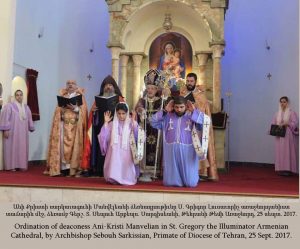 The female diaconate has been restored with the ordination of Ani-Kristi Manvelian, 24, in Tehran as a deacon for parish life who is not a nun.
The female diaconate has been restored with the ordination of Ani-Kristi Manvelian, 24, in Tehran as a deacon for parish life who is not a nun.
It is understood as a “restoring” rather than “reinstating” of the Order of Deacon for women. This act is see as a precedent. The ordination happened at St. Sarkis Church on 25 September 2017 by Archbishop Sebouh Sarkissian, the Primate of the Diocese of Tehran (Catholicosate of Cilicia).
Archbishop Sarkissian said:
“Today, our Church is confronting the imperative of self-examination and self-critique. It is imperative to rejuvenate the participation of the people in the social, educational and service spheres of the Church. It is our deep conviction that the active participation of women in the life of our Church would allow Armenian women to be involved more enthusiastically and vigorously, and would allow them to be connected and engaged. They would provide dedicated and loving service [to the people]. The deaconess, no doubt, would also be a spiritual and church-dedicated mother, educator, and why not, a model woman through her example. It is with this deep conviction that we are performing this ordination, with the hope that we are neither the first nor the last to do it.”
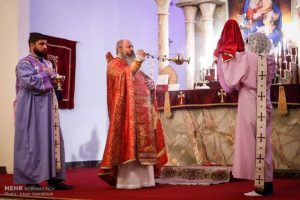 The narrative of the event was communicated by Hratch Tchilingirian on his blog.
The narrative of the event was communicated by Hratch Tchilingirian on his blog.
The Armenians have had a tradition of female deacons serving, like the male deacons, at the Altar.
Deaconess Ani-Kristi Manvelian served the Christmas Eve Liturgy on January 5th. For the Archbishop his act as the head of diocese is “to revitalise the participation of women also in our church’s liturgical life,” adding, “do not be surprised, a woman could also become a servant of the Holy Altar.”
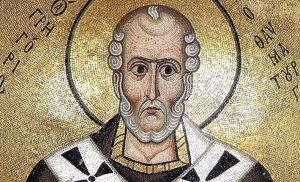 After his education, Gregory married and became a teacher of rhetoric. We do not know what happened to his wife, but the influence of his older brother Basil was strong enough to draw Gregory to monastic life. In 371, Basil arranged for his election as bishop of Nyssa, a town in Basil’s province. It was a political move intended by Basil to stem the influence of the Arians. Gregory was not happy with this sudden thrust into the fray, and he was not a very effective ally, and his brother criticized him for his lack of firmness. In the following decade he was deposed by the Arians, and later restored. His brother died, and Gregory came into his own. he was a prominent participant in the 2nd Ecumenical Council. He wrote scriptural commentaries and spoke of the concept of theosis, or deification as a luminous darkness, the ultimate paradox of union with God. His mystical theology is an early expression of the apophatic method which places more certainty in what we cannot say or know about divine truths. (NS)
After his education, Gregory married and became a teacher of rhetoric. We do not know what happened to his wife, but the influence of his older brother Basil was strong enough to draw Gregory to monastic life. In 371, Basil arranged for his election as bishop of Nyssa, a town in Basil’s province. It was a political move intended by Basil to stem the influence of the Arians. Gregory was not happy with this sudden thrust into the fray, and he was not a very effective ally, and his brother criticized him for his lack of firmness. In the following decade he was deposed by the Arians, and later restored. His brother died, and Gregory came into his own. he was a prominent participant in the 2nd Ecumenical Council. He wrote scriptural commentaries and spoke of the concept of theosis, or deification as a luminous darkness, the ultimate paradox of union with God. His mystical theology is an early expression of the apophatic method which places more certainty in what we cannot say or know about divine truths. (NS)
 “Stars cross the sky, wise men journey from pagan lands, earth receives its savior in a cave. Let there be no one without a gift to offer, no one without gratitude as we celebrate the salvation of the world, the birthday of the human race. Now it is no longer, Dust you are and to dust you shall return, but “You are joined to heaven and into heaven you shall be taken up.”
“Stars cross the sky, wise men journey from pagan lands, earth receives its savior in a cave. Let there be no one without a gift to offer, no one without gratitude as we celebrate the salvation of the world, the birthday of the human race. Now it is no longer, Dust you are and to dust you shall return, but “You are joined to heaven and into heaven you shall be taken up.”
St. Basil the Great
Feast of the Epiphany
At the beginning of a new year the following words of Father Alexander Schmemann give us much to think about:
“…What then gives meaning to a particular day, to the TODAY we live in? Is it not simply one day out of a long sequence of days that each one of us has to live through? Yet for me, as a Christian, its new and deep meaning comes from the past. It is a day related to Christ’s coming into the world, a day AFTER His coming, and thus the Christian is the one who first of all, REMEMBERS. He can forget Christ; he can wake up in the morning and think only of the petty concerns of that particular day, yet, on a deeper level, even these minor concerns become a very different experience if he remembers that he is not simply John Smith who has to do this or that, but the one to whom Christ has come, whose life Christ has assumed and has given new meaning. “Today,” however, has a second meaning, because it is also a day BEFORE Christ’s return. Thus I am always living between the two comings of Christ: the one in the past, the other in the future. And finally, the meaning of TODAY comes to me from the words of Christ, who says that He is ALWAYS with me. “And lo, I am with you always, to the close of the age” (Mt 27:20). Past, present, future – we see that the time in which we live is not only the time of the calendar, but the time that is shaped from inside and transformed by faith, by Christian experience. It is related to the coming of Christ in the past, to His coming in the future, and to His presence now…”